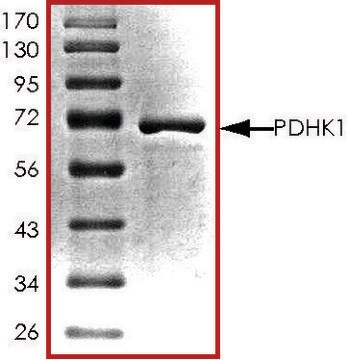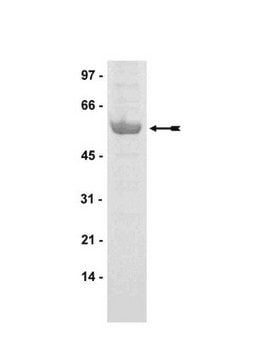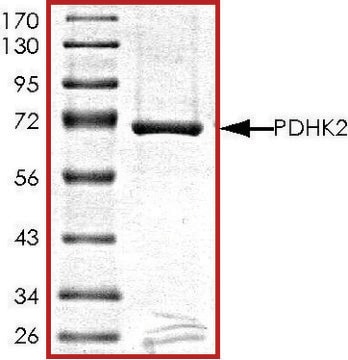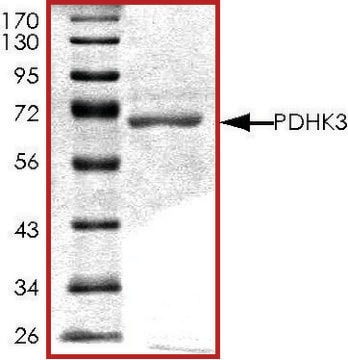K3393
PDK1, active, His tagged human
PRECISIO® Kinase, recombinant, expressed in baculovirus infected Sf9 cells, ≥70% (SDS-PAGE), buffered aqueous glycerol solution
Synonym(s):
PDPK1, PRO0461
Sign Into View Organizational & Contract Pricing
All Photos(1)
About This Item
UNSPSC Code:
12352200
NACRES:
NA.32
Recommended Products
recombinant
expressed in baculovirus infected Sf9 cells
Quality Level
product line
PRECISIO® Kinase
Assay
≥70% (SDS-PAGE)
form
buffered aqueous glycerol solution
specific activity
102-138 nmol/min·mg
mol wt
~67 kDa
shipped in
dry ice
storage temp.
−70°C
Gene Information
human ... PDPK1(5170)
Biochem/physiol Actions
PDK1 (3-phosphoinositide-dependent protein kinase) is activated by the presence of PtdIns (3, 4, 5) P3 or PtdIns (3, 4) P2. PDK1 then activates protein kinase B (PKB) which, in turn, inactivates glycogen synthase kinase-3 (GSK3). The phosphorylation of other proteins by PKB and GSK3 is likely to mediate many of the intracellular actions of insulin. Thus, PDK1 plays a key role in mediating many of the actions of the second messenger(s) PtdIns (3, 4, 5) P3 and/or PtdIns (3, 4) P2. The human PDK1 is a 556-residue monomeric enzyme comprising of a catalytic domain that is most similar to the PKA, PKB and PKC subfamily of protein kinases.
PDPK1 (3-phosphoinositide dependent protein kinase 1) is a serine/threonine protein kinase which is activated upon accumulation of PIP3 (phosphatidylinositol-3,4,5-trisphosphate), a PI3K (phosphoinositide 3-kinase) product. It controls AGC (protein kinase A, G, and C) kinase members, such as AKT (v-akt murine thymoma viral oncogene homolog), p70 ribosomal S6 kinase (S6K), serum- and glucocorticoid-induced protein kinase (SGK), and protein kinase C (PKC) members. It is involved in metabolism, growth, proliferation, and survival. PDPK1 is associated with growth of angiosarcoma cells.
Physical form
Supplied in 50mM NaPhosphate pH 7.0, 300 mM NaCl, 150 mM imidazole, 0.1mM PMSF, 0.2 mM DTT, 25% glycerol.
Legal Information
PRECISIO is a registered trademark of Merck KGaA, Darmstadt, Germany
Storage Class Code
10 - Combustible liquids
WGK
WGK 1
Flash Point(F)
Not applicable
Flash Point(C)
Not applicable
Personal Protective Equipment
dust mask type N95 (US), Eyeshields, Gloves
Certificates of Analysis (COA)
Search for Certificates of Analysis (COA) by entering the products Lot/Batch Number. Lot and Batch Numbers can be found on a product’s label following the words ‘Lot’ or ‘Batch’.
Already Own This Product?
Find documentation for the products that you have recently purchased in the Document Library.
Joanna Zabkiewicz et al.
Haematologica, 99(5), 858-864 (2013-12-18)
PDK1 is a master kinase that activates at least six protein kinase groups including AKT, PKC and S6K and is a potential target in the treatment of a range of malignancies. Here we show overexpression of PDK1 in over 40%
Makoto Wada et al.
Journal of dermatological science, 78(1), 44-50 (2015-03-03)
Angiosarcoma is a rare and aggressive malignant neoplasm of endothelial cells. Recent studies have shown that the mTOR pathway is also aberrantly activated in cutaneous angiosarcoma. New therapeutic strategies are required because the prognosis of this disease is still poor.
Jing Tan et al.
Cancer discovery, 3(10), 1156-1171 (2013-07-28)
Although 3-phosphoinositide-dependent protein kinase-1 (PDK1) has been predominately linked to the phosphoinositide 3-kinase (PI3K)-AKT pathway, it may also evoke additional signaling outputs to promote tumorigenesis. Here, we report that PDK1 directly induces phosphorylation of Polo-like kinase 1 (PLK1), which in
P Cohen et al.
FEBS letters, 410(1), 3-10 (1997-06-23)
The initial steps in insulin signal transduction occur at the plasma membrane and lead to the activation of phosphatidylinositide (PtdIns) 3-kinase and the formation of PtdIns(3,4,5,)P3 in the inner leaflet of the plasma membrane which is then converted to PtdIns(3,4)P2
D R Alessi et al.
Current biology : CB, 7(4), 261-269 (1997-04-01)
Protein kinase B (PKB), also known as c-Akt, is activated rapidly when mammalian cells are stimulated with insulin and growth factors, and much of the current interest in this enzyme stems from the observation that it lies 'downstream' of phosphoinositide
Our team of scientists has experience in all areas of research including Life Science, Material Science, Chemical Synthesis, Chromatography, Analytical and many others.
Contact Technical Service







